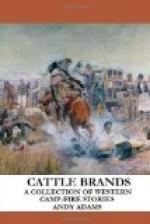At daybreak the round-up moved into the next pasture, the wagons, cut and saddle horses following. The special inspector was kept so busy for the next week that he never had time to look over the winter drift and strays, which now numbered nearly two thousand cattle. When the work ended the inspector missed the line-back steer. He said nothing, however, but exercised caution enough to take what cattle he had gathered up into Kansas for pasturage.
When the men who had gone that year on the round-up on the western division returned, there was a man from Reece’s camp in the Strip, east on Black Bear, who asked permission to leave about a dozen cattle in the Pool. He was alone, and, saying he would bring another man with him during the shipping season, he went his way. But when Reece’s men came back after their winter drift during the beef-gathering season, Bold Richard Larkin bantered the one who had left the cattle for a poker game, pitting the line-back three-year-old against a white poker cow then in the Pool pasture and belonging to the man from Black Bear. It was a short but spirited game. At its end the bar-circle-bar steer went home with Reece’s man. There was a protective code of honor among rustlers, and Larkin gave the new owner the history of the steer. He told him that the brand was of record in McMullen County, Texas, warned him of special inspectors, and gave him other necessary information.
The men from the Coldwater Pool, who went on the eastern division of the round-up next spring, came back and reported having seen a certain line-back poker steer, but the bar-circle-bar had somehow changed, until now it was known as the pilot wheel. And, so report came back, in the three weeks’ work that spring, the line-back pilot-wheel steer had changed owners no less than five times. Late that fall word came down from Fant’s pasture up west on the Salt Fork to send a man or two up there, as Coldwater Pool cattle had been seen on that range. Larkin and another lad went up to a beef round-up, and almost the first steer Bold Richard laid his eyes on was an under-bit, line-back, once a bar-circle-bar but now a pilot-wheel beef. Larkin swore by all the saints he would know that steer in Hades. Then Abner Taylor called Bold Richard aside and told him that he had won the steer about a week before from an Eagle Chief man, who had also won the beef from another man east on Black Bear during the spring round-up. The explanation satisfied Larkin, who recognized the existing code among rustlers.
The next spring the line-back steer was a five-year-old. Three winters in that northern climate had put the finishing touches on him. He was a beauty. But Abner Taylor knew he dared not ship him to a market, for there he would have to run a regular gauntlet of inspectors. There was another chance open, however. Fant, Taylor’s employer, had many Indian contracts. One contract in particular required three thousand northern wintered cattle for the Fort Peck Indian Reservation in northeast Montana. Fant had wintered the cattle with which to fill this contract on his Salt Fork range in the Cherokee Strip. When the cowman cast about for a foreman on starting the herd for Fort Peck, the fact that Abner Taylor was a Texan was sufficient recommendation with Fant. And the line-back beef and several other poker steers went along.




